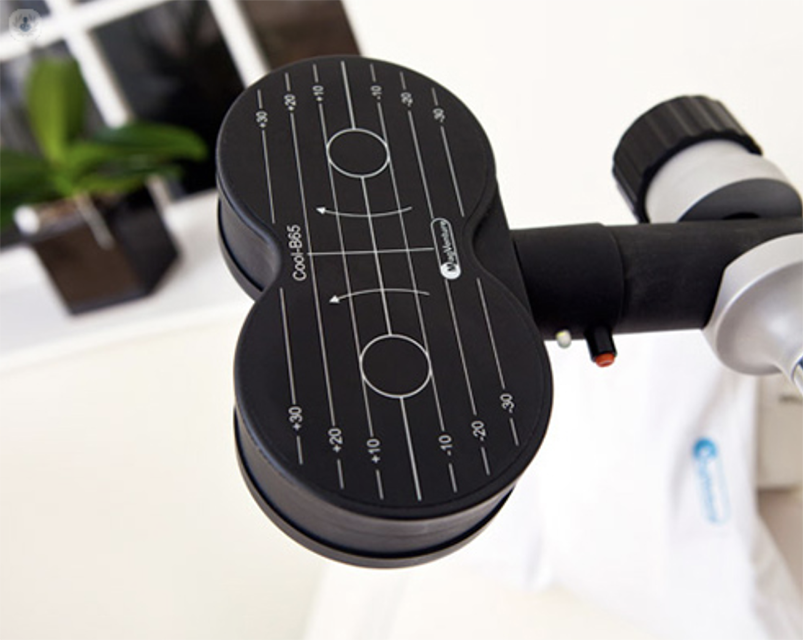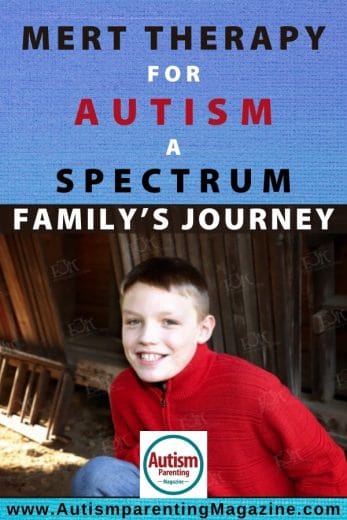MeRT Treatment for Autism
A New, Non-Invasive, Drug-Free Therapy

The MeRT Approach
MeRT®, or Magnetic e-Resonance Therapy, is a breakthrough treatment for Autism. The Brain Treatment Center uses FDA-cleared TMS equipment to generate a gentle magnetic field to balance and stimulate brain function. This process is guided by sophisticated diagnostics and imaging.
MeRT is an emerging technology that aims to improve brain function and communication. The TMS equipment used is FDA-cleared to treat Major Depressive Disorder and OCD and is used off-label to treat a wide variety of conditions, including autism spectrum disorder.
As a result of MeRT treatment, those with autism may open up for the very first time, allowing them to experience and interact more with the world. Our doctors have often seen improvements in eye contact, communication, understanding directions, and a sense of calm that reduces outbursts.*
This is happening because our doctors are locating brain areas with low or very low activity. They then use magnetic stimulation to open them up. This activates these unused pathways in the brain, allowing the patient to process their environment at a higher level. It is completely non-invasive, as we are simply using magnetic waves to stimulate brain activity and connectivity.
Our scientific approach has produced incredible results. Our board-certified MD, Dr. Julie Kim, has used MeRT successfully on hundreds of patients.
From Parents of Patients on the Spectrum
Highly recommended. In the first two weeks we began to see small changes, as the therapy progressed there were more changes, my son spoke more, more eye contact, he was more integrated into the family and his environment, better sleep quality (now he sleeps through the night); he had moments of hyper activity as a side effect but these disappeared at the end of the therapy. There is no better fight than the one that is not done, it is worth risking, it is worth trying, it is worth MERT. We are happy with our son’s changes!!!!” – Maria
This place is amazing!! We brought our daughter here for an assessment and decided to proceed with treatment. On the EEG we were able to see where there could be improvements – after 2 weeks of treatment another EEG is done so you can compare and contrast to make sure the treatment is working. There is notable improvements in her cognition and her ability to focus at school.” – Grace
MeRT: A Non-invasive, Drug-Free Treatment for Children on the Autism Spectrum
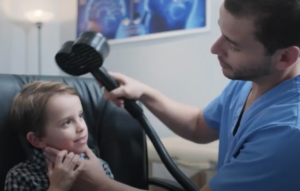
The Brain Treatment Center uses MeRT technology with guided electromagnetic stimulation to balance and stimulate brain function, all based on sophisticated diagnostics and imaging.
MeRT could be considered a version of TMS (Transcranial Magnetic Stimulation) that is more closely guided to focus on only the parts of the brain where activity and communication are sub-optimal.
With a diagnosis of autism, early intervention is key to the child’s development. Here at the Brain Treatment Center, we have helped hundreds towards more enjoyment of their unique life! MeRT can be used in conjunction with any other type of therapy.
Call Our New Patient Coordinator to Learn More
We Are Happy to Discuss Your Specific Situation
Call (619) 255-2101
Personalized Treatment
We tailor our MeRT treatment protocols for each patient to help reach optimal performance. And it’s important to note that each child will have a different starting point based on where they are on the spectrum. However, regardless of where your child or loved one may start, we generally see improvements as brain function is improved.*
MeRT protocols work by optimizing brain communication to be more organized and in sync. This can allow those with autism to have better communication skills, social skills, and more independence. And that means a higher quality of life for both the patient and the parent or any caregiver.
It is unique because all other therapies — such as ABA and school — also often improve as the brain pathways open up.
How MeRT Works to Treat Autism
MeRT stands for Magnetic e-Resonance Therapy. MeRT is a version of TMS (Transcranial Magnetic Stimulation), closely guided to work on only the parts of the brain with sub-optimal activity and communication.
What makes MeRT different from standard TMS treatment is the comprehensive testing we do beforehand. We create a detailed map of the brain with a qEEG (quantitative electroencephalogram). The qEEG shows us the specific brain function of each patient – and where the brainwaves may be out of sync.
Brain Patterns Found in Autism
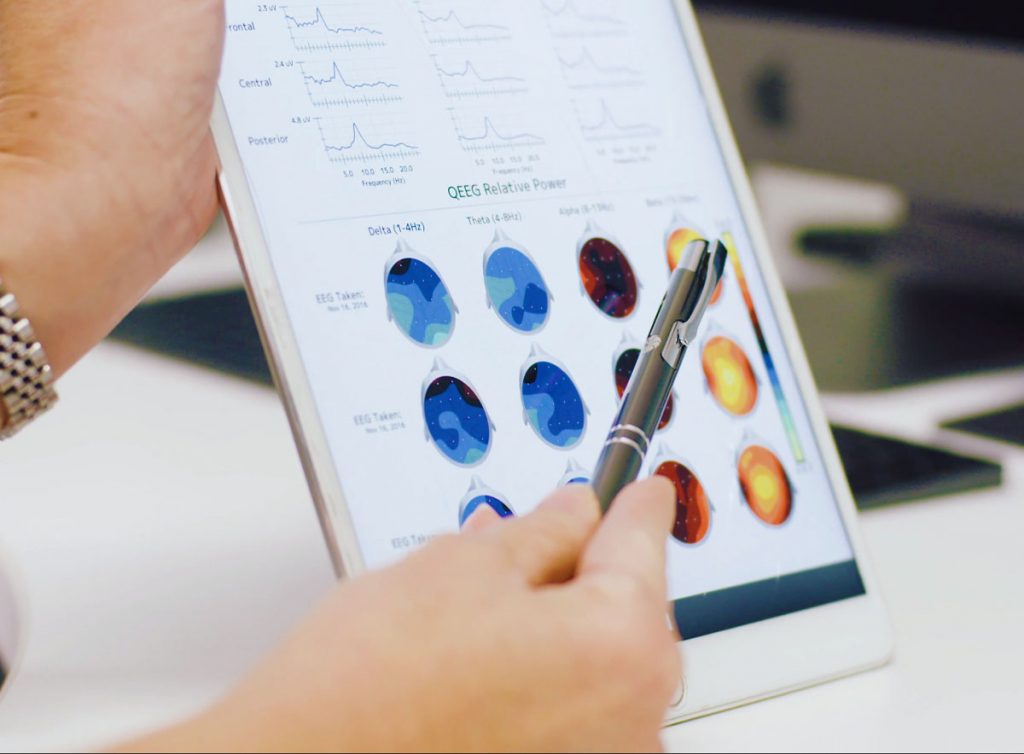
No two people will have the same experience with autism, but some commonalities exist. Autism often causes issues with how a person communicates and views the outside world. It may affect many social skills, learning, interacting with others, and the ability to function independently of care.
The qEEG will show different electrical signals in the brain of a child with autism compared to a child without ASD.
Those affected with autism will often have signature indicators that appear in the front three-fourths of the brain. A mix of slow (Delta & Theta wave) and high (Beta wave) frequency behavior dominates these brainwaves.
This differs from that of a neurotypical patient, who would usually have one dominant frequency in the alpha band of activity.
MeRT protocols work by neuromodulating brain waves based on the qEEG results. This optimizes brain communication, helping it be more organized and in sync.
This can help your child to be higher functioning — allowing for a higher quality of life for both your child and you.*
Dr Julie Kim, MD, is a Pioneer in MeRT Treatment

A board-certified internist with over two decades of medical experience, Dr. Julie Kim is the Medical Director of the Brain Treatment Center in San Diego. She also serves as Medical Director for the original Flagship Brain Treatment Center in Newport Beach.
Over the past decade, Dr. Kim has treated over 6,000 patients with MeRT (Magnetic e-Resonance Therapy). In fact, she was one of the first doctors to work with MeRT technology and is the most experienced MeRT clinician in the world.
Because of her expertise and experience, Dr. Kim co-created the initial safety protocols and physician training programs and has worked to train and support other physicians.
In the past four years alone, she has trained over 100 physicians to interpret qEEG results and use the full MeRT protocols.
Dr. Kim has seen MeRT therapy change the lives of not only her patients but also the community surrounding each patient. That’s why she’s so passionate about bringing this technology to as many people as possible.
Hear it from a parent…
I want to say that MeRT has changed my son’s life. I want to thank everyone who works at BTC Newport Beach! Dr. Kim was always very nice and kind to our family. She answered all of our questions, even the ones we thought it was too trivial to ask.
All of the technicians at BTC Newport Beach were awesome. They were all very patient with my child, who is very sensitive and has a very low level of concentration, so that he could go through everyday’s therapy with no problem. I really felt like every technician truly cared about all the children who were there getting MeRT, and I personally think this is the most important aspect to consider when getting MeRT, because the staff are the ones that the children would interact with every day. Last, but not least, the patient care coordinators were very helpful with the schedules, documents, etc. They made our visit much more comfortable. Thank you all very much!
I want to discuss how MeRT has helped my child. There are 3 major changes I have noticed about my child after 8 weeks of treatment. First, the eye contact. Like most autistic kids, my child’s ability to keep eye contact was very poor. After the treatment, his eye contact lasts much longer, many times for the entire conversation. Not only does he look at me longer, but he really LOOKS at me.
Second, his awareness has improved. When I tried to talk to him before, he would mostly repeat what I had just said. After the treatment, he seems to better understand what I am saying to him. Now, he demands more, he is more insistent (in a good way), and heals uses many new words. Our communication is much more meaningful.
Last, he has improved in fine motor skills. My child did not show much interest in using pencils or scissors, because he simply could not use them very well. But now, he draws pictures and writes letters with different writing tools, and even cuts out complex shapes with scissors.
MeRT did not cure my child. However, out of many different therapies I had for him for the past several years, this has been the most effective therapy by far which brought noticeable changes in a short period of time. I hope this testimonial would help the parents who are considering MeRT for their child, and also wish that more autistic children can benefit from MeRT!” – J. H.
Studies Show MeRT’s Effectiveness in Treating Autism Spectrum Disorder Symptoms
Targeted rTMS (repetitive transcranial magnetic stimulation) is a key element of our MeRT treatment for autism. Many studies show the effectiveness of rTMS for autism treatment. Here are some of the most recent:
A systematic review of transcranial magnetic stimulation treatment for autism spectrum disorder (May 31, 2024)
After TMS intervention, discernible enhancements across a spectrum of scales are evident in stereotyped behavior, repetitive behavior, and verbal social domains. A comprehensive review of literature spanning the last five years demonstrates the potential of TMS treatment for ASD in ameliorating the clinical core symptoms.
“Recent findings generally indicate that TMS has positive effects on stereotypical behavior, repetitive behavior, verbal and social aspects of ASD, leading to overall improvement across all scale scores post-intervention.”
Repetitive transcranial magnetic stimulation modulates long-range functional connectivity in autism spectrum disorder (April 2023)
The findings of this study demonstrate that high-frequency rTMS over the parietal lobe is potentially an effective strategy to improve core symptoms by enhancing long-range connectivity reorganization in ASD.”
Outcomes from Individual Alpha Frequency Guided Repetitive Transcranial Magnetic Stimulation in Children with Autism Spectrum Disorder – A Retrospective Chart Review (2022)
Conclusion: This study presents evidence on the efficacy and safety of α-rTMS in improving ASD symptoms, quality of life and comorbid sleep troubles in children. However, these findings should be interpreted as preliminary pending the presentation of double-blind, randomised clinical trials.”
Impact of repetitive transcranial magnetic stimulation on the directed connectivity of autism EEG signals: a pilot study (December 2022)
rTMS provides changes in connectivity and behavior, suggesting its potential use as a viable treatment option for ASD individuals.”
Transcranial Magnetic Stimulation in Autism Spectrum Disorders: Neuropathological Underpinnings and Clinical Correlations (June 24, 2020)
TMS is a non-invasive therapeutic intervention capable of modulating evoked and induced gamma oscillations and altering maladaptive behaviors83. Recent reviews of the literature suggest that TMS is safe and effective when used in ASD.”
Autism spectrum disorders: linking neuropathological findings to treatment with transcranial magnetic stimulation (April 2015)
Several rTMS trials in ASD have shown marked improvements in motor symptomatology, attention and perceptual binding.
“Conclusion: rTMS is the first therapeutic attempt at ASD aimed at correcting some of its core pathology.”
As MeRT is EEG-guided rTMS,, it is even more tailored to each individual based on their brain scans, making it even more precise.
Autism Parenting Magazine Features MeRT Treatment Success
In the third week, something happened. The family was driving around sight-seeing when they realized that they were getting lost in the California desert. Mary and Frank began to argue, and right in the midst of it, the moment they had waited six years for finally came.
“‘I remember he said a seven-word sentence basically to the effect of “I want you two to stop fighting.”And it shocked me so much that I almost stopped breathing,’ Frank recounts. ‘I looked at my wife and said, “Do you realize what just happened? He just said a seven-word sentence.” I had tears in my eyes, and I was happy at the same time. He was so upset that it pushed these words through.
“From there, Frankie’s progress snowballed. They returned home after only a month, but the difference between the child who arrived in California and the one who left was striking.
“They had taken a video of Frankie on the plane when they started the journey, ‘and he’s just making baby babble,’ Frank says. ‘We have another video of him on the plane coming back. And he looks out the window and says, “Goodbye California, see you soon.” This was a nonverbal kid, 30 days later. And his feet are flat on the ground.’
“Doctors said Frankie would continue to improve even without regular MeRT, albeit a bit slower. Today, he is 11 years old, verbal, and attends a public school.
“He tells Frank stories about times when he wanted to speak but couldn’t. ‘He goes, “You know, I’m so glad we went to the brain treatment because now I can talk,’” says Frank.”
Benefits We Have Seen from MeRT Treatment for Autism

- Improved Eye Contact
- Less anxiety, more relaxed
- More independence
- Improved concentration and focus
- Better interaction with others
- Response to Directions
- Improved sleep
- Longer sleep duration
- Improved mood, Less Anxiety
- Increased ability to cope with stress
- Greater attention span
- More sociability
- More motivation to learn
- Better emotional stability
- Increased ability to adapt to change
- Greater self-confidence and self-esteem
- More “presence” in the world going on around them
- Improved language skills
*Results vary from patient to patient and are not guaranteed
Find out if Your Child May Benefit from MeRT Treatment
We are Here for You!
Call (619) 255-2101
The Exact Steps of MeRT Treatment
We understand that MeRT is a relatively new treatment, and you may not be sure if this is right for your situation. However, this is not a decision you have to make right away or all alone.
Phone Consultation
Your first step is a simple phone consultation with our New Patient Coordinator. In this free, no-obligation consultation, you can discuss symptoms and history, ask all the questions you want, and have her explain the protocols and fees. She can also explain the treatment itself further.
After the call, if you are interested in taking the next step, we can set up an appointment for a qEEG (a simple, painless, and non-invasive brain scan).

First Appointment
When you come in for your first appointment, we will perform the qEEG and EKG, as mentioned above in the Treatment Overview section. These tests will help us evaluate brain activity and show any dysfunction. The qEEG, or brain mapping, is a valuable tool that lets us customize treatment for YOU.
Our chief neurotechnician performs the qEEG/EKG testing, which takes approximately an hour to complete for autism mapping. At this time, we will also gather your new patient paperwork and schedule you for your initial assessment period of treatment.
Second Appointment
Your second appointment will be a clinical evaluation with Nurse Practitioner Kayleigh Prowse, which takes approximately 45 minutes. You can have this appointment via Telemedicine or in-clinic, whichever you prefer. Please note that if you choose a Telemedicine appointment and are seeking treatment for your child, your child will need to be present.
During this consultation, Kayleigh will answer all your questions and discuss your applicable treatment plan. You will also have an opportunity to meet with our physician and Medical Director, Julie Kim, M.D.
Assessment Period
We recommend six weeks of treatment for patients undergoing MeRT to achieve optimal and long-lasting results. However, prior to committing to the six weeks, we have each patient go through an assessment period of treatment to see how they will respond. This assessment period is included in the six weeks of treatment.

Additionally, your provider will cover the follow-up qEEG results for you.
Treatment
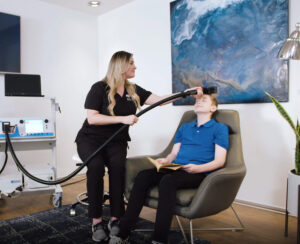
You should start to feel the benefits of treatment within a week or two, but because treatment is cumulative, you should continue to note improvements throughout your treatment and even for some weeks afterward.
Additionally, because we perform treatment on consecutive days, you must be able to stay in or around the San Diego area while undergoing your therapy.
Because each person’s brain and condition are unique, we customize treatment protocols for each patient, guided by the qEEG results. Repeat qEEGs and clinical consultations occur every two weeks throughout treatment.
As a note, the potential side effects of treatment are minimal and should begin to dissipate as you progress through treatment. Moreover, the effects of treatment generally last a lifetime, though some patients prefer occasional follow-up treatment as needed.
* MeRT improvements and results are based on strict and active observation of our treatment protocols. Results may vary between people and are not guaranteed.
Interested, but not Sure?
Talk with our New Patient Coordinator
It costs nothing to call us and talk about what is happening.
Our New Patient Coordinator is here for you.
During your call, she can answer any question or concern you may have.
She can also explain the process and protocols, costs, possible insurance benefits, and any other details.
It’s important to note that there are no obligations, and she will take the time you need to know whether you should take the next steps.
Call Our New Patient Coordinator to Learn More
(619) 255-2101
Or fill in the form below, and she will contact you.
Contact Us
For more information or to speak with our New Patient Coordinator, please fill in the information below.
Insurance for MeRT Treatment
Unfortunately, Insurance does not cover treatment for autism at this time.
We are out-of-network and cannot file insurance on your behalf. However, we can provide you with the paperwork at the end of your treatment. Then you can submit it to your insurance company to see if they will reimburse you. (We are In-Network with military TriCare Insurance, but they only cover treatment for Depression and do not provide any coverage for children under 18 years old or for Autism.)
Currently, rTMS (which covers MeRT) is FDA-approved for Depression and OCD (Obsessive Compulsive Disorder.) For non-FDA-approved treatment, it is not likely that insurance will provide reimbursement for our protocols.
Some patients have reported that they have been able to receive some reimbursement for EEGs or clinical evaluations. However, this depends on their health coverage. Medicare patients have reported that their coverage provides no reimbursement for MeRT.
Care Credit
Care Credit is also an option to help finance medical expenses and is a separate company from The Brain Treatment Center San Diego. This is a credit card you can use to cover medical expenses and services, which typically offers zero-interest financing for 12 months.
Usually, when you go to the Care Credit website and apply, they will rapidly let you know if you receive approval.

